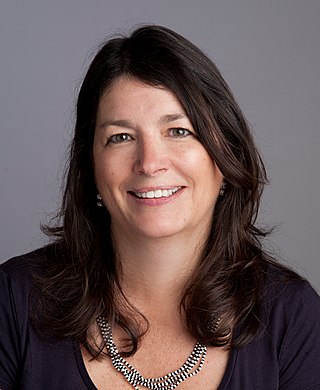Related Research Articles

J. Lamar Worzel was an American geophysicist known for his important contributions to underwater acoustics, underwater photography, and gravity measurements at sea.

Marie Tharp was an American geologist and oceanographic cartographer. In the 1950s, she collaborated with geologist Bruce Heezen to produce the first scientific map of the Atlantic Ocean floor. Her cartography revealed a more detailed topography and multi-dimensional geographical landscape of the ocean bottom.
The Lamont–Doherty Earth Observatory (LDEO) is the scientific research center of the Columbia Climate School, and a unit of The Earth Institute at Columbia University. It focuses on climate and earth sciences and is located on a 189-acre campus in Palisades, New York, 18 miles (29 km) north of Manhattan on the Hudson River.

Paul E. Olsen is an American paleontologist and author and co-author of a large number of technical papers.

RV Maurice Ewing was a research vessel operated by the Lamont–Doherty Earth Observatory of Columbia University. It was retired in 2005 and replaced by RV Marcus Langseth in 2008. Although a multipurpose vessel, Maurice Ewing's notable capability was to collect multichannel seismic data.

R/V Marcus Langseth is a research vessel owned and operated by the Lamont–Doherty Earth Observatory (LDEO) of Columbia University as a part of the University-National Oceanographic Laboratory System (UNOLS) fleet. The Marcus G. Langseth was dedicated on December 4, 2007, came into service in early 2008, replacing the R/V Maurice Ewing. Langseth is intended primarily to collect multichannel seismic data, including 3-D surveys. The ship was purchased from the geophysical survey company WesternGeco in 2004, having previously been named Western Legend.
Walter Clarkson Pitman III was an American geophysicist and a professor emeritus at Columbia University. His measurements of magnetic anomalies on the ocean floor supported the Morley–Vine–Matthews hypothesis explaining seafloor spreading. With William Ryan, he developed the Black Sea deluge theory. Among his major awards are the Alexander Agassiz Medal and the Vetlesen Prize.
SedDB was created as an online data management and information system for sediment geochemistry.
Dallas Abbott is a research scientist at the Lamont–Doherty Earth Observatory of Columbia University and is part of the Holocene Impact Working Group. The primary focus of her present research is on submarine impact craters and their contribution to climate change and megatsunamis. She also has presented research regarding a large impact crater in the Gulf of Maine.

Robert D. Conrad (T-AGOR-3) was a Robert D. Conrad-class oceanographic research ship that operated from 1962 to 1989. The ship, while Navy owned, was operated as the R/V Robert D. Conrad by the Lamont–Doherty Earth Observatory of Columbia University from delivery to inactivation. The ship provided valuable ocean-bottom, particularly seismic profile, information and underwater test data to the U.S. Navy and other U.S. agencies.
The Vetlesen Prize is a prize in geology awarded jointly by Columbia University's Lamont–Doherty Earth Observatory and the G. Unger Vetlesen Foundation. The prize is generally regarded as the highest distinction in geologic studies, and the "Nobel Prize for geology".
Georg Unger Vetlesen was a Norwegian-American shipbuilder and philanthropist.
Two international geophysical societies offer awards each year which are named in honor of Maurice Ewing; these are the American Geophysical Union and the Society of Exploration Geophysicists.

Maureen E. "Mo" Raymo is an American paleoclimatologist and marine geologist. She is the Co-Founding Dean of the Columbia Climate School, Director of the Lamont–Doherty Earth Observatory of Columbia University, the G. Unger Vetlesen Professor of Earth & Environmental Sciences, and Director of the Lamont–Doherty Core Repository at the Lamont–Doherty Earth Observatory of Columbia University. She is the first female climate scientist and first female scientist to head the institution.

Sean Carl Solomon is the director of the Lamont–Doherty Earth Observatory of Columbia University, where he is also the William B. Ransford Professor of Earth and Planetary Science. Before moving to Columbia in 2012, he was the director of the Department of Terrestrial Magnetism at the Carnegie Institute in Washington, D.C. His research area is in geophysics, including the fields of planetary geology, seismology, marine geophysics, and geodynamics. Solomon is the principal investigator on the NASA MESSENGER mission to Mercury. He is also a team member on the Gravity Recovery and Interior Laboratory mission and the Plume-Lithosphere Undersea Melt Experiment (PLUME).

Allan Wie Hwa Bé was a micropaleontologist. He was considered a pioneer in research about planktonic foraminiferal ecology. He also served as president of the Cushman Foundation for Foraminiferal Research.

Robin Elizabeth Bell is Palisades Geophysical Institute (PGI) Lamont Research Professor at Columbia University's Lamont–Doherty Earth Observatory and a past President of the American Geophysical Union (AGU), 2019–2021. Dr. Bell was influential in co-ordinating the 2007 International Polar Year and was the first woman to chair the National Academy of Sciences Polar Research Board. She has made numerous important discoveries with regard to subglacial lakes and ice sheet dynamics, and has a ridge, called Bell Buttress, in Antarctica named after her.
Marco Tedesco is an Italian climate scientist at the Lamont–Doherty Earth Observatory at Columbia University.
Kirsteen Jane Tinto is a glaciologist known for her research on the behavior and subglacial geology of the Greenland and Antarctic ice sheets.
Ellen Sue Kappel Berman is a science communicator in the area of oceanography. After earning her Ph.D. in marine geology and geophysics, Kappel worked as program manager for the Ocean Drilling Program and later established a company helping to make the case for funding of geoscience programs. She has been the head editor of Oceanography since 2004.
References
- ↑ "Helga Gomes". Lamont–Doherty Earth Observatory.
- ↑ "Massive outbreaks of Noctiluca scintillans blooms in the Arabian Sea due to spread of hypoxia". Nature.com. 9 September 2014.